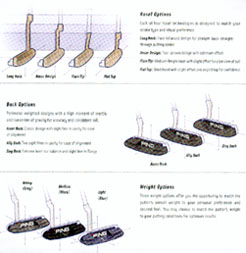
Ping’s Specify putter range.
|
The beauty of publishing on the internet is interaction. In this case Ping read a forum discussion on GOLFmagic, then decided to invite me up to be fitted for one of their unique custom-fit putters. Then, being as convinced of the benefits of custom-fitting as they are, decided to offer GOLFmagic readers, like you, the chance to win one!
I never really got the hang of Meccano and Lego as a kid; never had the patience for screwing together metal strips or interlocking coloured bricks. I preferred to kick, hit, bowl or head a ball around all day.
But I can instantly see the appeal of building my own putter – as launched by Ping - having discovered in recent years all the new tricks a computer can offer. It’s a wonder no one thought of it before.
Ping has its European headquarters in Gainsborough, and it was there I visited to discover how to create my own personalised, custom-fit putter. Though you don’t have to travel to the wilds of north Lincolnshire, you can ‘build’ one in the comfort of your own home or even at your office desk.
Ping’s own website is currently out of action being modified but by logging on to Pinggolf.com
(the US site) you can literally feel your way through the easy-to-follow programme to fit yourself with a putter of your own choice, to your personal specification.
It’s then a case of printing out your completed form, handing it to your local dealer with a cheque for £130 and it should be delivered between 7-10 days.
 |
Images of the ‘virtual putter.’
|
Here’s what I had to do…
Having established my height (5ft 7in), wrist-to-floor measurement (33.5in) and stance (conventional, upright or crouched), the interactive programme needed to know my stroke type (wristy or pendulum), my hand position at impact (pronounced forward press or conventional)and my stroke path (inside-square-inside or straight through).
The fact that I switched my putting grip from left-below-right to a Chris di Marco-style ‘Claw grip’, sadly seemed of no consequence to the computer! Perhaps if one of the US tour’s top putters had been a Ping player it might have been programmed into the computer!
Nevertheless, it identified that based on the way the sole of the putter touched the ground, I needed a putter with a Red dot lie (4 degree flat, standard loft) for someone who tended to keep his hands low at address and the toe of the club in the air. I’m also more comfortable with a shorter shaft of just 31.5 inches (compared with the conventional 33 –35 ins) and this was allowed for in the programme. I had at least seven choices of rubber grip and plumped for the chunky Karsten Etched.
Having established my own stance, grip and putting style it was time to identify a putter that was visibly appealing from a choice of up to 36 combinations. After all, how many of us, having budgeted a price, buy a car based on its colour and shape rather than its petrol consumption and cornering?
The Specify putters have four hosel options: Long neck (face-balanced design for straight-back-straight through putting stroke, Anser (Tour-proven, optimum offset), Flare-Tip (medium length hosel with slight offset for clear view of the ball) or Flat Top (short hosel with slight offset and angled top for confidence). The computer gave me the chance to view them ‘virtually’ from every angle.
 |
Hosel, back and weight options of the Specify.
|
For years I’ve used a heavy, brass-headed ‘Parr One’ Ping-copy putter with a cut-off shaft that reacted well on slow greens, so in a bid to change my luck, opted for the medium-weighted black version as opposed to the heavyweight (grey) or lightweight (blue) options. In a computerised ‘overview’ the black also appeared easier on the eye at address against the gunmetal face.
With a preference for needing to nonchalantly pick up the ball with the back of the putter, any of the three back-shape options would have sufficed, but the less fussy, cradle-style and single sight line of the Zing back suited me better, compared to the angles of the Ally (two sight lines) and classic Anser (one sight line).
Ping’s chairman, John Solheim claims the Specify will take putter customisation to the next level and certainly my own specifications were achieved within 15-20 minutes of making a series of fascinating choices.
"It’s a far-reaching and innovative putter concept that we’ve created with the fitting-conscious golfer in mind," he says. "The visual contrast of the stainless steel face and the dark flange is also very striking and beneficial to golfers.
"The colour contrast of the front and back of the putters increases the golfer’s ability to align the putter to the target, and that translates to optical comfort and improved confidence over the ball," says Solheim, who also believes it
‘promotes squareness’ to simplify putting alignment.
 |
How my chosen putter will look.
|
Having submitted my order, I now await, with great anticipation, my custom-fitted, DIY Specify putter.
And Perhaps, having created it myself, I’ll also achieve yet more
notoriety at my local golf course, as Bob the Builder!
*All Ping Specify putters will be serialised and are available in right and left-handed models, though left-handers a facility to visibly reverse the images on their computer screen is not available. Ping suggests left-handers complete their details on screen (as if right-handed), print them out and make it clear to their local dealer the club is for a left-hander, when submitting their order. For your nearest dealer call Ping’s consumer line 01427 619224.






